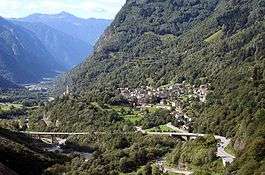Soazza
| Soazza | ||
|---|---|---|
 | ||
| ||
 Soazza  Soazza | ||
|
Location of Soazza  | ||
| Coordinates: 46°21′N 9°13′E / 46.350°N 9.217°ECoordinates: 46°21′N 9°13′E / 46.350°N 9.217°E | ||
| Country | Switzerland | |
| Canton | Graubünden | |
| District | Moesa | |
| Area[1] | ||
| • Total | 46.42 km2 (17.92 sq mi) | |
| Elevation | 620 m (2,030 ft) | |
| Population (Dec 2015[2]) | ||
| • Total | 347 | |
| • Density | 7.5/km2 (19/sq mi) | |
| Postal code | 6562 | |
| SFOS number | 3823 | |
| Surrounded by | Cauco, Lostallo, Menarola (IT-SO), Mesocco, Rossa, San Giacomo Filippo (IT-SO) | |
| Website |
www SFSO statistics | |
Soazza is a municipality in the Moesa Region in the Swiss canton of Graubünden.
History
Soazza is first mentioned in 1203 as Soaza.[3]
Geography
Soazza has an area, as of 2006, of 46.4 km2 (17.9 sq mi). Of this area, 7.2% is used for agricultural purposes, while 53.7% is forested. Of the rest of the land, 1.5% is settled (buildings or roads) and the remainder (37.7%) is non-productive (rivers, glaciers or mountains).[4]
Demographics
Soazza has a population (as of 31 December 2015) of 347.[2] As of 2008, 11.9% of the population was made up of foreign nationals.[5] Over the last 10 years the population has decreased at a rate of -6.9%. Most of the population (as of 2000) speaks Italian (91.9%), with German being second most common ( 3.3%) and Serbo-Croatian being third ( 2.2%).[4]
As of 2000, the gender distribution of the population was 54.4% male and 45.6% female.[6] The age distribution, as of 2000, in Soazza is; 37 children or 10.3% of the population are between 0 and 9 years old. 17 teenagers or 4.7% are 10 to 14, and 10 teenagers or 2.8% are 15 to 19. Of the adult population, 35 people or 9.7% of the population are between 20 and 29 years old. 64 people or 17.8% are 30 to 39, 49 people or 13.6% are 40 to 49, and 42 people or 11.7% are 50 to 59. The senior population distribution is 51 people or 14.2% of the population are between 60 and 69 years old, 37 people or 10.3% are 70 to 79, there are 16 people or 4.5% who are 80 to 89, and there is 1 person who is 90 to 99.[5]
In the 2007 federal election the most popular party was the CVP which received 34.9% of the vote. The next three most popular parties were the SP (28.5%), the SVP (26%) and the FDP (9.2%).[4]
In Soazza about 73.3% of the population (between age 25-64) have completed either non-mandatory upper secondary education or additional higher education (either university or a Fachhochschule).[4]
Soazza has an unemployment rate of 2.6%. As of 2005, there were 24 people employed in the primary economic sector and about 9 businesses involved in this sector. 71 people are employed in the secondary sector and there are 7 businesses in this sector. 38 people are employed in the tertiary sector, with 14 businesses in this sector.[4]
The historical population is given in the following table:[3]
| year | population |
|---|---|
| 1650 | 427 |
| 1802 | 311 |
| 1850 | 315 |
| 1900 | 339 |
| 1950 | 348 |
| 2000 | 359 |
Heritage sites of national significance
The Casa Paret, the Church of S. Martino including the della Madonna Addolorata and the Ospizio e Via Crucis are listed as Swiss heritage sites of national significance.[7]
 Church of S. Martino
Church of S. Martino- Church of S. Martino
References
- ↑ Arealstatistik Standard - Gemeindedaten nach 4 Hauptbereichen
- 1 2 Swiss Federal Statistical Office - STAT-TAB, online database – Ständige und nichtständige Wohnbevölkerung nach institutionellen Gliederungen, Geburtsort und Staatsangehörigkeit (in German) accessed 30 August 2016
- 1 2 Soazza in German, French and Italian in the online Historical Dictionary of Switzerland.
- 1 2 3 4 5 Swiss Federal Statistical Office accessed 22-Oct-2009
- 1 2 Graubunden Population Statistics (in German) accessed 21 September 2009
- ↑ Graubunden in Numbers (in German) accessed 21 September 2009
- ↑ Swiss inventory of cultural property of national and regional significance 21.11.2008 version, (in German) accessed 22-Oct-2009
| Wikimedia Commons has media related to Soazza. |
External links
- Official website (in Italian)/(in German)
- Soazza in German, French and Italian in the online Historical Dictionary of Switzerland.
